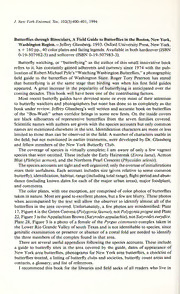
Butterflies through Binoculars, a Field Guide to Butterflies in the Boston, New York, Washington Region by Jeffrey Glassberg PDF
Preview Butterflies through Binoculars, a Field Guide to Butterflies in the Boston, New York, Washington Region by Jeffrey Glassberg
J. New YorkEntomol. Soc. 102(3):400-401, 1994 ButterfliesthroughBinoculars,AFieldGuidetoButterfliesintheBoston,NewYork, WashingtonRegion.—JeffreyGlassberg. 1993. OxfordUniversityPress, NewYork, x + 160pp., 40colorplatesandfacinglegends. Availableinbothhardcover(ISBN 0-19-507982-5) and softcover (ISBN 0-19-507983-3). Butterfly watching, or “butterflying” as the author ofthis small innovative book refers to it, has constantly gained adherents and currency since 1974 with the pub- licationofRobertMichaelPyle’s“WatchingWashingtonButterflies,”aphotographic field guide to the butterflies ofWashington State. Roger Tory Peterson has stated that butterflying is at the same stage that birding was when his first field guides appeared. A great increase in the popularity ofbutterflying is anticipated over the coming decades. This book will have been one ofthe contributing factors. Most recent butterfly guides have devoted some or even most oftheir attention to butterfly watchers and photographers but none has done so as completely as the book underreview. Jeffrey Glassberg’s well written and accurate book onbutterflies ofthe “Bos-Wash” urban corridor brings in some new firsts. On the inside covers are black silhouettes of representive butterflies from the seven families covered. Scientific names with authors are given with the species accountsbut only common namesare mentionedelsewhereinthetext. Identificationcharactersare moreorless limited to those than can be observed in the field. A number ofcharacters usable in the field, but not mentioned in earlier treatments, were developed by Dr. Glassberg and fellow members ofthe New York Butterfly Club. The coverage ofspecies is virtually complete; I am aware ofonly a few vagrant species that were omitted. These include the Early Hairstreak {Erora laeta Acmon ), Blue (Plebejus acmon), and the Northern Pearl Crescent (Phycoides selenis). Thespeciesaccountsaretightandwellorganized;onlytheoveruseofinitializations mars their usefulness. Each account includes size (given relative to some common butterfly),identification,habitat,range(includingtotalrange),flightperiodandabun- dance (including known dates for each ofthe major urban areas), major foodplant, and comments. The color plates, with one exception, are comprised ofcolor photos ofbutterflies takeninnature. Mostaregoodtoexcellentphotos,butafewareblurry. Thesephotos when accompanied by the text will allow the observer to identify almost all ofthe butterflies in the area covered. Unfortunately, a few photos are misidentified: Plate 17,Figure4istheGreenComma(Polygoniafaunus), notPolygoniaprogneandPlate 22,Figure3istheAppalachianBrown(Satyrodesappalachia),notSatyrodeseurydice. Plate 28, Figure 3 is a photo ofa female ofthe Pyrgus communis complex taken in the Lower Rio Grande Valley ofsouth Texas and is not identifiableto species, since genitalic examination or presence or absence ofa costal fold are needed to identify the three members ofthe complex found in that area. There are several useful appendices following the species accounts. These include a guide to butterfly sites in the area covered by the guide, dates ofappearance of New Yorkarea butterflies, phenograms forNew York area butterflies, a checklist of butterflies treated, a listing ofbutterfly clubs and societies, butterfly countareas and contacts, a glossary, and list ofreferences. I recommend this book for the libraries and field sacks ofall readers who live in 1994 BOOKREVIEWS 401 the area covered. The usefulness ofthe book declines as one travels away from the coverage area. Elsewhere in the easternU.S. otherbooks suchasthe recent Peterson Field Guide should be referenced.—Dr. PaulA. Opler, National Biological Survey, 1201 OakRidgeDrive, Suite 200, Fort Collins, Colorado 80525. J. New YorkEntomol. Soc. 102(3):401—403, 1994 A Functional Biology ofParasitism: Ecological and Evolutionary Implications.—G. W. Esch and J. C. Fernandez. Chapman and Hall, Cambridge, 1993. ISBN 0 412 39910 5; 337 pp., 81 figs. Therehasbeen a steadilygrowinginterestintherole ofparasitesinecologicaland evolutionary studies during the latter half of this century. This interest has been encouraged by the search for rigorous approaches to the issues ofhistorical associ- ations (coevolution) ofhosts and parasites and the related historical ecology, mi- croevolutionary arms race scenarios between hosts and parasites, the relationships betweenparasitesandsexual selectionoftheirhosts, theRed-Queenhypothesis, and the ecological constraints surroundingparasite and host community structures. Par- asites have become so compelling as research subjects, in fact, that “A Functional Biology ofParasitism” by Esch and Fernandez will be found on book store shelves alongside, and in competition with, otherrecent works suchas “Phylogeny, Ecology and Behaviour” and thejust released “Parascript” both by Brooks and McLennan as well as “Natural Enemies” by Crawley and “Bird-Parasite Interactions” by Loye andZuk. The strengthsof“AFunctionalBiology ofParasitism” areprimarilyinthe field ofhost-parasite community structure and dynamics. Those interested in phy- logenetic or biogeographical aspects ofparasite biology should, however, look else- where as these are dealt with in only a cursory way by Esch and Fernandez. The Introduction may well dissuade many from going on and reading the rest of the bookas itjumps straightinto helminthology, movingfrom one specific example to the next rather than priming the reader with a fewgeneralizations about parasite biology. This is unfortunate as it does a disservice to the contentsthat follow. Little is given up by moving quickly to the second chapter, Population Concepts, and perhaps readingthe last chapter, the Summary, before decidingwhetherto proceed. The most valuable contribution made by the authors is that chapters 3 through 7 serve as an unrivaled compilation ofcase studies ofhelminth parasite population biology and a valid attempt to summarize elements of modem ecological theory withina parasitologicalframework. Moreover, the perspectivesofinfra-, meta-, and suprapopulationsaremaintainedthroughout, notonlyinthetextbutinthegraphical representations oflife cycles. Some factors that play fundamental roles in the life- histories and transmission dynamics ofhelminths are addressed (Chapter 3), as are factors involved in host population structure (Chapter4). With respect to the latter, theauthorsprovideausefuldigressioninto the originsofmodem methodologywith Crofton’searlyapproachesto parasiteregulationofhostpopulationsleadingintothe more realistic approaches ofMay and well-designed investigations by Scott. Unfor- tunately, thenaivereadermightbeleftwiththeexpectationthatparasitesareknown
